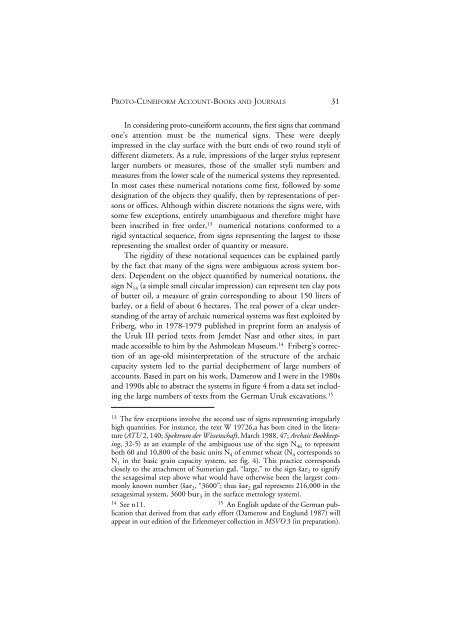PDF copy - Cuneiform Digital Library Initiative - UCLA
PDF copy - Cuneiform Digital Library Initiative - UCLA
PDF copy - Cuneiform Digital Library Initiative - UCLA
You also want an ePaper? Increase the reach of your titles
YUMPU automatically turns print PDFs into web optimized ePapers that Google loves.
PROTO-CUNEIFORM ACCOUNT-BOOKS AND JOURNALS 31<br />
In considering proto-cuneiform accounts, the first signs that command<br />
one’s attention must be the numerical signs. These were deeply<br />
impressed in the clay surface with the butt ends of two round styli of<br />
different diameters. As a rule, impressions of the larger stylus represent<br />
larger numbers or measures, those of the smaller styli numbers and<br />
measures from the lower scale of the numerical systems they represented.<br />
In most cases these numerical notations come first, followed by some<br />
designation of the objects they qualify, then by representations of persons<br />
or offices. Although within discrete notations the signs were, with<br />
some few exceptions, entirely unambiguous and therefore might have<br />
been inscribed in free order, 13 numerical notations conformed to a<br />
rigid syntactical sequence, from signs representing the largest to those<br />
representing the smallest order of quantity or measure.<br />
The rigidity of these notational sequences can be explained partly<br />
by the fact that many of the signs were ambiguous across system borders.<br />
Dependent on the object quantified by numerical notations, the<br />
sign N 14 (a simple small circular impression) can represent ten clay pots<br />
of butter oil, a measure of grain corresponding to about 150 liters of<br />
barley, or a field of about 6 hectares. The real power of a clear understanding<br />
of the array of archaic numerical systems was first exploited by<br />
Friberg, who in 1978-1979 published in preprint form an analysis of<br />
the Uruk III period texts from Jemdet Nasr and other sites, in part<br />
made accessible to him by the Ashmolean Museum. 14 Friberg’s correction<br />
of an age-old misinterpretation of the structure of the archaic<br />
capacity system led to the partial decipherment of large numbers of<br />
accounts. Based in part on his work, Damerow and I were in the 1980s<br />
and 1990s able to abstract the systems in figure 4 from a data set including<br />
the large numbers of texts from the German Uruk excavations. 15<br />
13 The few exceptions involve the second use of signs representing irregularly<br />
high quantities. For instance, the text W 19726,a has been cited in the literature<br />
(ATU 2, 140; Spektrum der Wissenschaft, March 1988, 47; Archaic Bookkeeping,<br />
32-5) as an example of the ambiguous use of the sign N46 to represent<br />
both 60 and 10,800 of the basic units N4 of emmer wheat (N4 corresponds to<br />
N1 in the basic grain capacity system, see fig. 4). This practice corresponds<br />
closely to the attachment of Sumerian gal, “large,” to the sign ·ar2 to signify<br />
the sexagesimal step above what would have otherwise been the largest commonly<br />
known number (·ar2, “3600”; thus ·ar2 gal represents 216,000 in the<br />
sexagesimal system, 3600 bur3 in the surface metrology system).<br />
14 See n11.<br />
15 An English update of the German publication<br />
that derived from that early effort (Damerow and Englund 1987) will<br />
appear in our edition of the Erlenmeyer collection in MSVO 3 (in preparation).
















